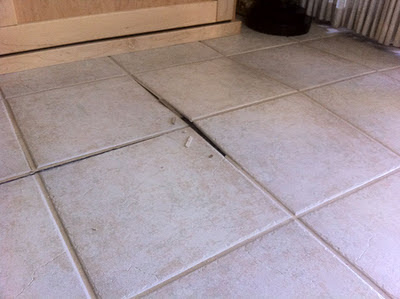As in most things, knowledge is key and laying floor tile is no exception. Today we'll look at some potential problems that can occur from incorrect floor tile installations and what you can do to avoid them.
Cement backer board
Illustration of Ditra installation
Concrete slabs
Many tile installations are laid directly onto concrete slabs by adding a layer of thinset and applying the tile directly. However the potential problem here lies in the two items, the concrete slab and the tile. Concrete, like everything, expands and contracts and it does so at a different rate than the tile that is adhered to it. Naturally when two attached items move at different rates, something has to give and in this case it's usually the tile. Wooden sub floors will also move at different rates. The resulting movement to the tile is called "tenting" and much as the name implies the tile looks like a little tent when forced together.Tenting
The solution is to add a layer between the subfloor and the tile that uncouples the floor whether that floor is concrete or wood. Using a cement board from various manufacturers or a product from Schluter called "Ditra."
Cement backer board
Illustration of Ditra installation
Both products will effectively keep the subfloor and tile moving around at their own rates, leaving all parties content and in place.
Below is a great video showing the installation of floor tile and Ditra done properly. This is for a wood substrate but Ditra is also a great product to use on concrete slabs too.
Tenting can also happen because the tile was grouted right to the baseboard versus leaving that last wall to joint empty (no grout there) and applying the baseboard above the tile. This leaves a place for expansion. Another area of potential concern are kitchen and bath cabinets so make sure that you allow for expansion areas along those edges too.
Plants
Oddly you may not even consider this one but plants that are large and in heavy pots can cause tenting. Due to the large size of the plant, pot and soil and if they are occupying a few tiles on the floor, those tiles are not being allowed to move at the same rate as their neighboring tiles and the result may be a large cracking noise some evening as the tile moves or rather the other tiles move.
Expansion joints in large areas
You may also want to consider or confer with your installer about installing an expansion joint and again this one is made by Schluter. Generally a distance of 25'-30' is the most that an area should be tiled without adding an expansion joint such as shown below.
Another area that re-modelers often face is when two different substrates are to receive a new tile floor. For example part of the area to be tiled is concrete and part is wood. Here we have two different movements to contend with as they both contract and expand at totally different rates. Adding a layer of cement board or Ditra will uncouple the two from the tile and allow them to move at their own rates without effecting the tile above.
Thinset and grout
This one is easy. Just remember that all thinset and grout are made with Portland cement and are dry bagged products. If you are doing the installation yourself and see a premixed thinset or grout on your store shelf and think you'll be saving time and effort, you probably won't be. The product you are viewing is not what you generally will be needing. My advice if you are trying to do a tile installation for the first time, make sure you read and learn all that you can to avoid problems down the road. If you are not 100% sure? My advice would be to hire a professional installer as it will be money well spent over the lifetime of your tiled floor and avoidance of future problems.




2 comments:
Important and insightful post, Todd! Another good resource for tile advice and tile installation problems can be found at JohnbBridge.com. For instance, you can find more information about today's topic: Floor Tile Installation Problems - 'Tenting'.
I actually had a nice talk with John when we were both at Coverings in April. Great guy and very knowledgeable.
Post a Comment